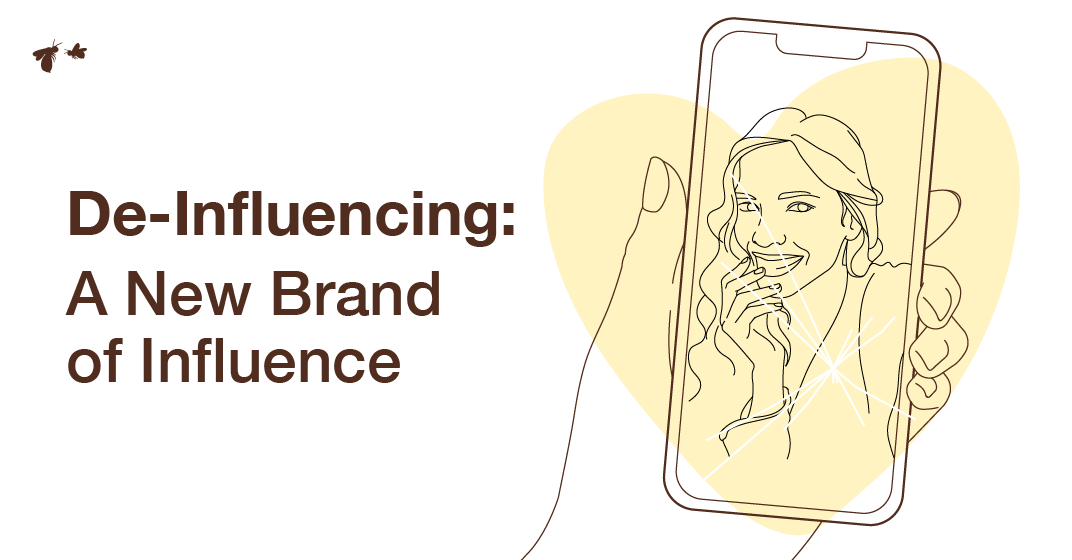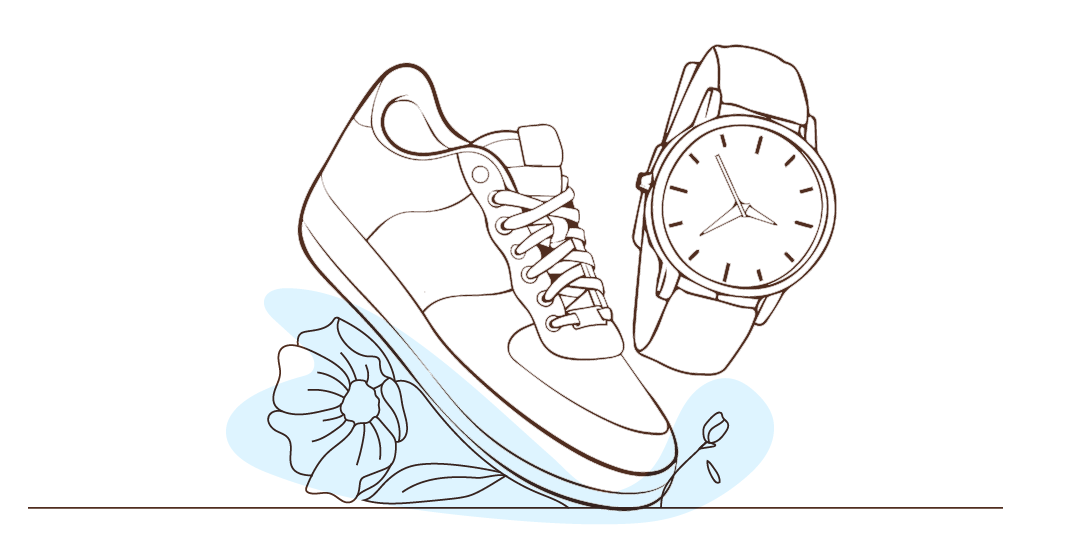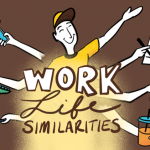De-Influencing: A New Brand of Influence

A stranger tells you to buy something. Do you? What about if they tell you not to buy something? Are you more likely to trust a negative review than a positive one? In today’s world of mass consumption fueled by online rankings and reviews, it’s become tough to tell the difference between genuine opinions and advertisements. And so materializes, de-influencing.
What Does De-Influencing Mean?
You may have heard this new term on TikTok, or if you don’t have the mental capacity for another social media platform like me, it may have been mentioned to you by a more in-the-loop coworker. The term is funny to me because, upon doing research, many media outlets described it as “exactly like it sounds.” But the true definition is not the first thing I thought of. As someone who works in marketing, I figured it meant that companies were moving away from the use of influencers, trying not to persuade the minds of consumers at all—but encouraging them to try products out for themselves. Now that would be something worth making headlines over…but would also threaten our entire industry’s well-being, so luckily, it’s not that.
What de-influencing really means? A new kind of influencer that tells people which products to avoid. Refinery29 put it as, “Instead of waxing lyrical about shiny new launches, they’re recommending what not to buy, or letting their followers in on the best affordable dupes.”i So, while these content creators are still telling you how you should spend your money (cough cough influencing), this new approach focuses more on appealing to what Gen Z values (sustainability, affordability, sincerity) and less on what Millennials aspire to have (designer clothes, luxury skincare, trendy health supplements, the latest tech). Social media analyst Jasmine Enberg said, “De-influencing is still influencing. Creators are using their power to sway the purchasing decisions of a broader population. They’ve adapted to resonate with consumers during an economic downturn.”ii
That “economic downturn” is one of the big reasons content creators are switching to the label ‘de-influencer.’ Data journalist Chris Beer said, “The economy is in a very different situation. People are now thinking, ‘I don’t actually want to stand out as much when you know friends of mine are being laid off,’ or ‘I can’t post this stuff on social media because it might be seen as insensitive.’”iii
What Does Influencing Have to Do with the Economy?
Wealth and consumption have been driving forces throughout this global trend of internet influencer culture. Having shiny new things to show off to followers is now considered a career—one that can put a roof over your head and food on your table. But Gen Z is starting to show signs that they’re over seeing creators flaunting designer purses and thousand-dollar sneakers. Josie Bullard, a content creator herself, said, “… a lot of people, especially Gen Z, they’re a generation that wants to rebel against this like perfectly curated world that has been social media for the past decade…people are starting to crave something a little bit more real, authentic and relatable.”iii
Not only are audiences moving away from content flexing lavish lifestyles, but they’re becoming more critical of what they consider insincere endorsements of products. “TikTok users value authenticity and they are not afraid to call anyone out if they feel they are being inauthentic,” according to Trina Albus, a marketer and digital content creator.i
Why are Influencers Being Labeled as Inauthentic?
Audiences have begun to lose trust in all influencer endorsements. Some because they were persuaded into buying less-than-great products, others because the influencer found ways to falsify the results. In response to beauty brands abusing technology to alter the supposed results of their products, regulations have been put in place. The Advertising Standards Authority (ASA) has ordered beauty brands and influencers to stop using filters in social media campaigns, stating it as ‘misleading’ to viewers. Now, a handful of ads have actually been condemned for breaking the rules.i
But these kinds of regulations won’t be enough to keep the current system of influencing thriving. Users of platforms like TikTok and Instagram will start disregarding influencer’s endorsements just like generations before did with celebrities’. If you believe people only say what they do because they are getting paid, you’re not going to go out and purchase the products. TikTok expert Marina Mansour said, “…it’s the start of the end of lazy influencer marketing and that’s good news for everyone.” She thinks this de-influencing trend will bring much-needed transparency, regulation, accountability and trust to social media marketing.
While this trend is being fueled in part by an economic crisis and a desire for authenticity, there is one more major factor that younger generations are especially focused on: the environment.

What Does Influencing Have to Do with the Environment?
The traditional influencer, be they in beauty, fashion, health, cars or technology, promotes a lifestyle of overconsumption. Influencers are often given gifts and discounts from brands they support, and usually, the brand found them because they had already purchased from them—in a myriad of cases, many times.
Influencers buy, brands give them more, their followers buy, brands give them more, and this cycle continues until…well, the influencer says something offensive on video, or a newer, shinier creator comes along and buys their products, and the brand moves on. To many of us, this cycle has become nauseating. Seeing items pile up in a creator’s home until they inevitably move to a bigger, new build.
Overconsumption is just a quicker way of saying ‘you’re buying more than you need, encouraging mass production and perpetuating an unsustainable culture that is destroying our planet.’ TikToker @gabyhunt11 put it frankly as she addressed these beauty consumerists: “Use them up or give them away. Stop buying multiple products that do the same thing. Stop the clutter. Stop the waste. Save the money. Keep it simple and effective.”i
Zero Waste Week reported that 120 billion units of packaging are produced yearly by the global cosmetics industry.i When you consider that there are almost 8 billion people on Earth, and it’s likely a great deal less than half of us who use cosmetics, the math starts to get embarrassing. A fraction of the population produces 120 billion units of packaging a year just by way of beauty products, alone? This behavior cannot continue.
Some de-influencers are using this trend as an opportunity to promote reuse and secondhand purchasing. Aja Barber, author of Consumed: The Need for Collective Change – Colonialism, Climate Change & Consumerism, has been a sort of de-influencer long before the trend. “I will tell people: ‘I’m wearing these jeans from this maker. I wouldn’t buy them because this maker really needs to sign the accord for garment workers, but I know that they do very good plus sizes and so what I recommend is you go and buy them on eBay.’”i This method of de-influencing is likely to become very popular because it appeals to the same desire for a content creator to tell you what you should own, but in a way that encourages considering your environmental impact and holding brands accountable.

Has Influencer Marketing had a Major Shift Like This Before?
Pinpointing the exact origin of the influencer as we define them today is a lost cause. Everyone will have a different answer for you, but from a marketing perspective, the mommy blogger era may be the place to start the discussion.
Mom blogs started as a way for real mothers to connect and share their advice, struggles, milestones, tragedies and wins, in a truly authentic, essay-style digital format. This was back in the early 2000s, before images could be posted online by just anyone, so words led the charge. One of the most famous mom blogs was started by Heather Armstrong in 2001, called “Dooce.com.” By around 2009, she averaged 4 million page views a month, which at the time was very significant.v
But today, internet-famous moms are business-motivated, highly manicured women with seemingly perfect marriages and well-behaved children. Armstrong thinks, “It’s just so sad. It’s all these staged, curated photos that don’t show the messier part of life.”v The reason things shifted from raw and real to fluffy and fabricated? Advertisers.
According to Armstrong, “Advertising got a foothold and started having more and more say in things.”v She ended up quitting blogging for two years after getting herself mixed up in a contract that had her placing products into photos of her children. “They had me manufacture bullshit.” Another internet famous mom, Bunmi Laditan, creator of “The Honest Toddler,” says that, while mom blogging originally gained its popularity for being groundbreakingly honest, it’s become hard to find any mom bloggers telling the truth these days. “Companies don’t want to align themselves with the difficulties of motherhood. They want to align themselves with people who are winning.”v
Catherine Connors, creator of the blog “Her Bad Mother”, notes “People began to see they could make more money with aspirational content—because brands prefer it. Aspirational sells better than truth-telling.”vi So the space once for traditional mom bloggers was taken over by the lifestyle influencer moms, but the promise of authenticity and a real look inside the family home never went away.
This new generation has become masters at fabricating content just far enough (maybe a centimeter) from perfect that they can pretend it’s candid. Writer and mompreneurship student (yes, that’s a real area of study at Concordia University) Katheryn Jezer-Morton, talks about a group of moms she refers to as “The Los Angeles haute-slacker cohort of Busy Philipps, Kelly Oxford and Liz Carey,” saying “they write, they perform, they consult; they’re ambassadors. They’re profane and genuinely self-deprecating, but glossier and more aspirational than mothers have ever been.”vi People are led to believe that these influencers have perfect lives, and that if you just buy what they buy and do what they do, you can too.
This major shift in the culture of internet mom content laid a straightforward path for what is widely considered the traditional type of social media influencing. Advertisers picked up on what was working—sponsoring the aspirational creator’s content, because that’s where people were going for their advice, including what to spend their money on.
De-influencing may be the first significant step toward returning to the authentic, raw content style of the early mom blog era, but influencers as a concept, aren’t going anywhere soon. The former mom blogger Tracie Nall put it plainly, “We’ve seen many changes to the landscape over the years, but the one constant is growth: influencer marketing is showing no signs of slowing down.”vii
What Does De-Influencing Mean for Social Media Marketing, Online Shopping and the State of the Beauty Industry?
While it will take time for this culture of overconsumption and traditional influencer content to die down, things are likely to change for good. GWI found that consumers’ interest in what influencers wear has dropped by 16% since 2020.iii This is the result of consumers getting privy to the facts that influencers are getting gifted these items and may not actually enjoy them, this culture of overconsumption isn’t sustainable and with the state of the economy, they likely cannot afford most of these items anyway. PR agency founder, Sophie Attwood, found that “We’re looking for genuine recommendations from other users, reviewers, or authentic creators. There is power in truthful coverage as opposed to large advertising budgets or glossy advertorials.”i Audiences want to hear from real, regular people that brands have no relationship with.
This shift will cause a dramatic change in how brands plan their marketing. Right now, 95% of brands have used social media influencers to promote products. Influencing went from a $1.7 billion industry in 2016 to a $14.6 billion industry in 2022.iii Influencers who can’t adapt to their audience’s needs will get left behind. Trina Albus warns, “…content creators who value money and deals over authenticity should be worried.”i
The global beauty industry market is currently valued at $511 billion.i The imminent changes in our consumption habits are sure to significantly impact the success of this industry. It may be better for the planet, which is incredibly important, but what will it mean for the state of the economy? Will thousands of people lose their jobs as beauty companies can’t make the same numbers? Will influencers who have based their entire internet presence around beauty products no longer be able to sustain their lifestyles and need to change careers?

What Do We Make of All This?
There are a lot of worrying unknowns when it comes to the future of influencing and its impact on the economy. But it’s also important that we acknowledge this impending (hopefully) win for consumers, especially vulnerable audiences, and—more importantly—for the environment. She’s got enough shit to deal with as it is.
One thing we know for sure is that a strong brand is and will always be important—no matter what trends come and go. So, whether you are looking to move away from influencer marketing, are ready to try de-influencer marketing or want to beef up an influencer-focused campaign, BatesMeron knows how to make your brand strong and your marketing impactful.
What do you think about the de-influencing trend? Share your thoughts with us at heyyou@batesmeron.com !
i Arshad, Sahar. “In the Era of De-Influencing, Who Can We Trust?” Refinery29. February 17, 2023.
ii Bramely, Ellie Violet. “The sudden dawn of the de-influencer: can online superstars stop us from shopping?” The Guardian. February 22, 2023.
iii Green, Jordan. “‘De-influencing’ is going viral. What does this mean for the future of influencers?” Today.com. February 4, 2023.
iv Toumazou, Aaron. “What are influencers ‘de-influencing’?” LinkedIn. February 2023.
v Bailey, Sarah Pulliam. “How the Mom Internet became a spotless, sponsored void.” Washington Post. January 26, 2018.
vi Jezer-Morton, Kathryn. “Did Moms Exist Before Social Media?” The New York Times. April 16, 2020.
vii Nall, Tracie. “The History of Influencer Marketing and Mom Bloggers.” Sway Group. April 10, 2018.
Six Questions for Bob Healy
Why Figma Is Better Than Adobe for the Modern Designer
A Brutalism Renaissance: the Good, the Bad and the Ugly








